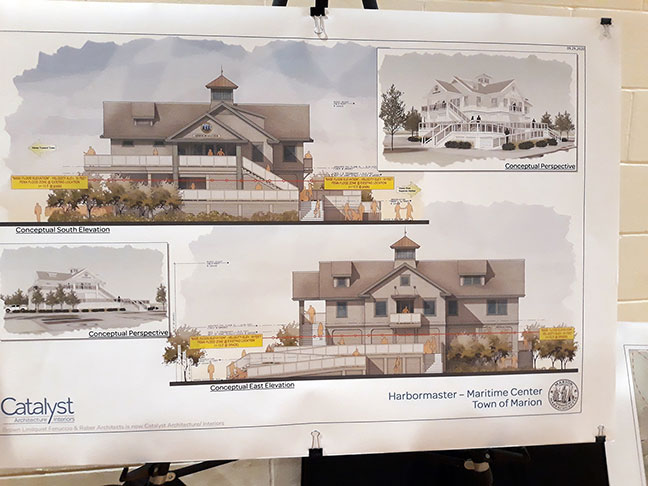The Marion Board of Selectmen met on Tuesday night at Sippican School in joint session with the Marion Marine Resources Commission for the latter’s presentation of the Harbormaster Facility Feasibility Study.
The September 29 meeting was held at Sippican to accommodate a swell of public interest also directed toward the Marion Open Space Acquisition Committee’s proposal to acquire conservation restrictions on land and implications for the town’s economy.
While they were at it, the selectmen closed the warrant for the Special Town Meeting that, due to a scheduling conflict for a selectman, was moved up from its originally scheduled date of Monday, November 9, to Thursday, November 5, at 6:45 pm at Old Rochester Regional High School.
In presenting on behalf of Harbormaster Isaac Perry and the Marine Resources Commission, Tim Sawyer of Catalyst Architects laid out a schematic and preliminary design plan for a new Maritime Center at Island Wharf.
As outlined by Town Administrator Jay McGrail, the study began last winter with a request for quotation (RFQ) and the formation of a small group to identify and assess needs of the harbormaster and the facilities at Island Wharf, to evaluate the site and then present at this meeting a preliminary design. The group held back on estimating cost in order to first see what the citizens think about the concept.
If the November 5 Special Town Meeting responds favorably, then the town will pursue the grant funding necessary to make a final, approved design and construction possible. McGrail told Tuesday’s meeting that funding completion, if necessary, could come from the town’s Waterways Account.
“This is a plan that’s worked in a number of communities,” he said, citing multi-million-dollar grants awarded by the state-based Seaport Economic Council in Duxbury, Harwich and Plymouth. Heretofore, the harbormaster has operated out of three separate locations, Island Wharf, the Town House and the recently sold Atlantis Drive property.
“The department has outgrown the facility operations years ago,” said Perry. “This is an opportune time to get the community involved and (achieve) a consensus.”
Marine Resources Commission Chairman Vincent Malkoski said, “One of the common themes is, ‘Oh my god, it’s too big.’” He asked residents to keep an open mind, see why what is proposed is proposed, and stressed that this is a public process. The plans are not final, “not even close … there is opportunity for change.”
Some reactions were astonishment at the size of the building (5,300 square feet total footprint) and height. As initially designed, it sits 2 feet above the maximum allowed in that zone and would need a variance.
The floor was opened to public comment.
Andrew Bonney suggested Marion needs to hold a deliberate conversation on what to ask the harbormaster to take on, noting that the department has grown substantially since it was designed in the 1980s. “I think this building sends the wrong message about what we think about our government,” he said. “That’s a really big building right down town. I for one don’t want the waterfront dominated by the town administration.”
Perry said he is not looking to increase staffing. “The big thing we’re looking to do is move the people from town hall,” he said.
Some suggested the new facility will function mainly to block the view of the harbor, but Jeff Dickerson, who lives at 180 Front Street, drew applause when he noted he cannot see the harbor because of invasive grass and fragmites that have grown over the years and said his own blocked view has nothing to do with a building. “This (project) is not an obstruction, this is a doorway to the harbor,” he said. “The demand is there, this is not an eyesore …”
The elevation of the main operating deck will reach 23 feet counting the piles and 16½ feet above grade. It will be accessible by ramps, centralize harbormaster operations and attract the public.
Andrew Daniel cautioned people against trying to get the building lower to the ground. “I built six houses on stilts … and (if you try to) get it a little lower, I challenge you to get it insured,” he said.
Malkoski said that Tabor Academy’s Oceanography facility is built on the same concepts.
Sawyer said that Catalyst has been around for 50 years and just changed its name from Brown, Lindquist, Fenuccio & Baber Architects to simplify its branding.
In closing the meeting so attendees could get home in time to watch the presidential debate, McGrail suggested residents with questions or comments email himself or Perry.
The end of the presentation was met with more applause.
Of rivaling controversy was the Marion Open Space Acquisition Committee’s proposals listed on Articles 5, 6, 7 and 8 of the warrant to purchase a conservation restriction for one parcel of land and accept three others as gifts, all to be used for conservation and passive recreation purposes. The proposal was presented by MOSAC Chairman John Rockwell and by Sippican Lands Trust member Dot Brown.
Public concern focuses on taking land out of sources for tax revenue.
Board of Selectmen Chairperson Randy Parker recused himself from the board for the matter, as he was involved in a donation of 7.8 acres on either side of his house lot for conservation restriction.
The rest of the warrant articles were read or summarized by McGrail, most notably Articles 3 and 4 outlining Marion’s strategy to withdraw from the Carver, Marion, Wareham Refuse District and its plan to take back ownership of the Benson Brook transfer station.
Prior to the public meeting, the selectmen met in a 6:00 pm Executive Session to discuss collective-bargaining strategy with the Department of Public Works in accordance with state General Law c. 30A, Section 21(a)(3).
The next meeting of the Marion Board of Selectmen was not yet scheduled.
Marion Board of Selectmen
By Mick Colageo
